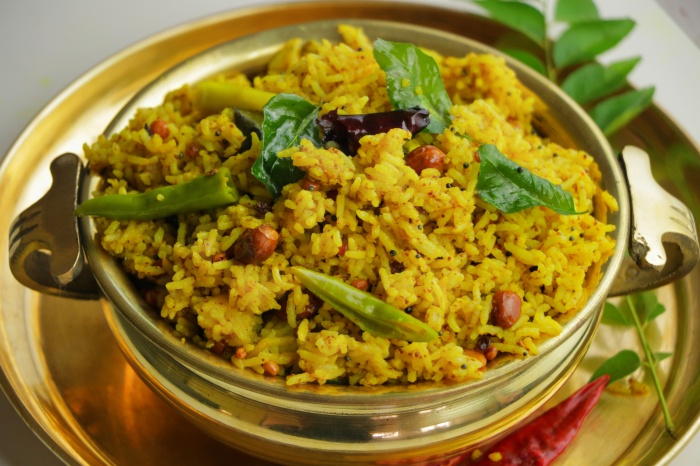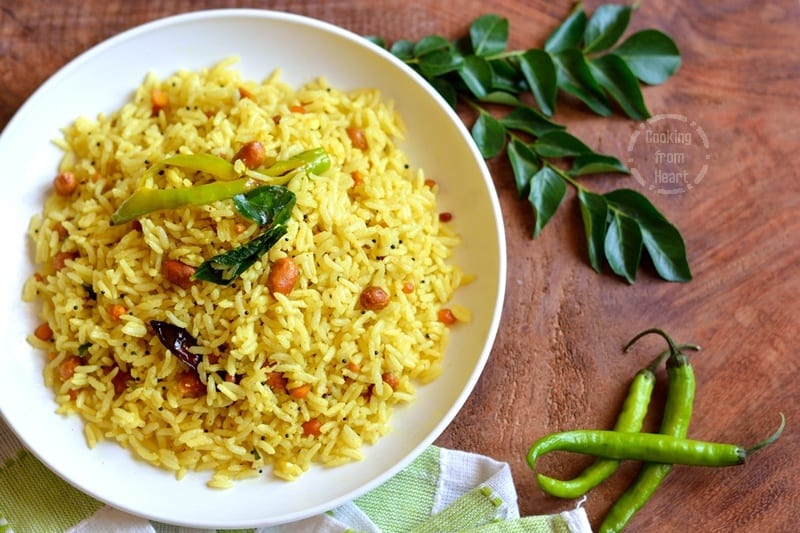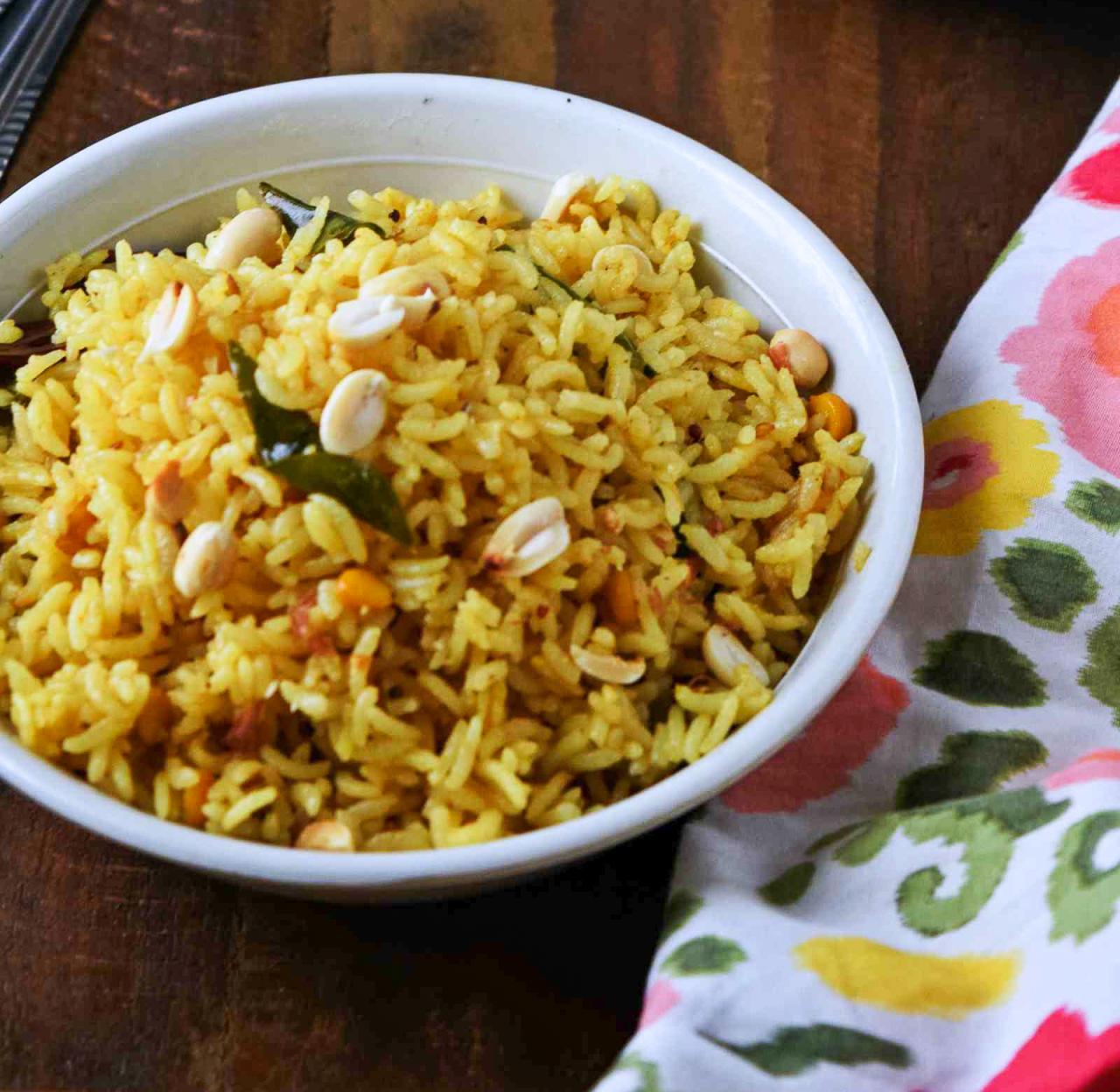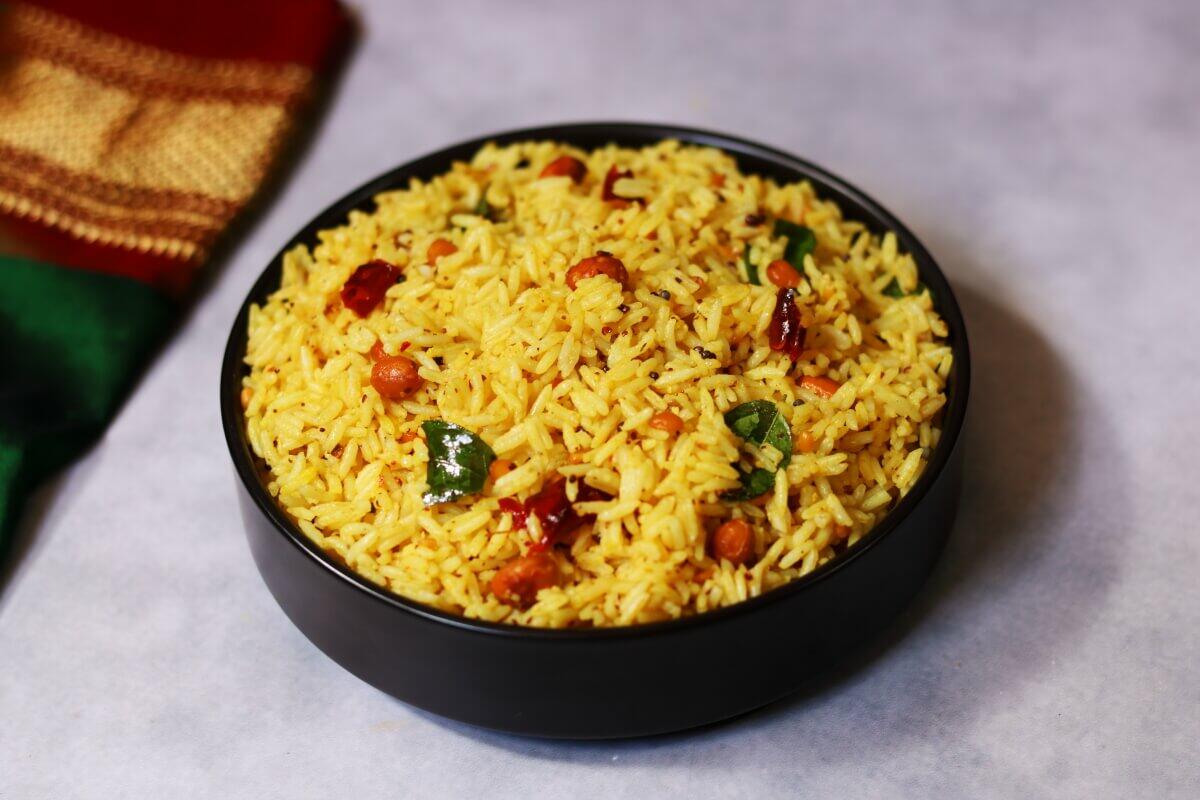Pulihora, also known as tamarind rice, is a traditional South Indian dish popular in various states such as Andhra Pradesh, Telangana, Tamil Nadu, and Karnataka. This dish is deeply ingrained in the region’s culinary heritage and is often prepared during festivals, religious ceremonies, and special occasions. The term ‘Pulihora’ can be broken down into two words in the Telugu language, where ‘puli’ means sour taste, typically referencing tamarind, and ‘hora’ refers to rice. However, the dish has different names in different regions, like ‘Puliogare’ in Kannada and ‘Puliyodarai’ in Tamil.
The preparation of pulihora is characterized by its tangy and savory flavors, which stem from the use of tamarind as its primary souring agent. To make pulihora, cooked white rice is mixed with a special spice paste containing tamarind extract, which gives the rice its distinctive tangy taste. This paste often includes various spices and seasonings such as mustard seeds, dried red chili, curry leaves, turmeric powder, asafetida (hing), fenugreek seeds, and sometimes a pinch of jaggery to balance the flavors.
Pulihora Tamarind Rice Recipe


Pulihora Tamarind Rice
Equipment
- 1 bowl
Ingredients
- 1 cup sona masoori rice rinsed with cool water, drained, and cooked according to the package directions
- 3 tablespoons sesame oil divided
- 1 small lime-size seedless tamarind block soaked in 1/2 cup boiling water for 30 minutes
- 1 teaspoon mustard seeds
- 2 teaspoons husked whole black lentils
- 2 teaspoons Bengal gram
- 2 curry leaf sprigs
- 3 dried Guntur chiles halved lengthwise
- 3 tablespoons peanuts
- 1/2 teaspoon asafoetida
- 2 green chiles finely chopped
- 1 tablespoon finely chopped peeled fresh ginger
- 11/2 teaspoons salt
- 1/2 teaspoon ground mustard
- 1/8 teaspoon ground turmeric
Instructions
- Spread the cooked rice on a plate and drizzle 1 tablespoon of sesame oil over it. Set aside.
- Stir the tamarind and the water it has been soaking in. Using your fingers, remove the tamarind flesh and squeeze the juice from the pods, removing any fibers and membranes. Pour the mixture into a fine-mesh strainer set over a bowl and use a spoon to press as much of the pulp as possible through the strainer. Set the tamarind pulp aside.
- In a large pan or wok over medium heat, heat the remaining 2 tablespoons of sesame oil.
- Add the mustard seeds, black lentils, Bengal gram, curry leaves, and Guntur chiles. Cook until the oil becomes frothy.
- Add the peanuts and asafoetida. Cook for 1 minute until the peanuts turn light brown.
- Add the green chiles and ginger and cook for 1 minute.
- Reduce the heat to medium-low and add the tamarind pulp, salt, mustard, and turmeric. Simmer for 10 minutes. The mixture will thicken as it simmers.
- Reduce the heat to low and cook for 3 minutes more. The mixture should be thick, like the consistency of jam. Turn off the heat. Add the mixture to the rice and stir thoroughly to combine.
Notes
Cooking Tips about Pulihora Tamarind Rice

Pulihora, also known as tamarind rice, is a traditional South Indian dish known for its tangy and spicy flavor, often served during festivals and special occasions. To ensure you can make the best possible Pulihora, let’s go through some tips and the traditional process step-by-step.
Before you begin, it is crucial to use rice that is fluffy and non-sticky after cooking. Normally, short-grained rice like Sona Masoori is preferred. The rice grains should be separate to allow for even mixing of the tamarind paste later on. For this texture, the rice is often washed and drained, then cooked with less water than usual.
Now let’s talk about the tamarind base. The quality of tamarind is key to the dish. It should be soaked in water to extract the pulp, which is then cooked down to create the base of this dish. The tanginess can be adjusted according to taste, but for an authentic Pulihora, it should have a prominent sour note.
The tempering is also an integral part of the dish. You’ll need mustard seeds, chana dal (split chickpeas), urad dal (black gram), dried red chilis, green chilis, curry leaves, and asafoetida (hing). The tempering ingredients should be fried in sesame oil, which adds a nutty flavor to the dish and is a healthier option compared to other oils.
It’s also important to add turmeric early in the tempering process for its vibrant yellow color, which is iconic to Pulihora. After the tempering is prepared, the tamarind paste is added and cooked to reduce rawness. To this, you add the rice and mix gently to avoid breaking the grains, ensuring that the rice is evenly coated with the paste.
Serving suggestions about Pulihora Tamarind Rice

- Temperature: Pulihora can be served warm or at room temperature. Serving it warm can accentuate its flavors and aromas.
- Accompaniments: Traditionally, Pulihora is enjoyed on its own, but it pairs well with simple sides such as plain yogurt or raita— a yogurt-based condiment made with vegetables like cucumber or tomato and flavored with herbs and spices.
- Portioning: Given its bold taste, it can be served in small portions as a part of a larger meal that includes more mildly flavored dishes like dal (lentil soup), sabzi (vegetable stir-fry), and papad (thin, crisp disc-shaped food).
- Nutritional Balance: To create a more nutritionally balanced meal, consider pairing Pulihora with protein-rich sides such as grilled paneer (a type of fresh cheese), fried or hard-boiled eggs, or a chickpea salad.
- Herbs and Fresh Elements: Adding fresh herbs like coriander leaves (cilantro) as a garnish can introduce a refreshing note to the dish. A squeeze of fresh lime juice before serving can also enhance the tanginess if desired.
- Variations: It’s common to find variations of Pulihora with added ingredients like grated coconut, diced green mango, or lemon juice as the souring agent instead of tamarind, providing slightly different flavor profiles.
- Packaging for Events: For distribution at events, Pulihora is often portioned into banana leaves or eco-friendly containers, which adds a subtle fragrance and is an eco-friendly serving option.
Top 5 FAQs about Pulihora Tamarind Rice

- What are the key ingredients in Pulihora (Tamarind Rice)? The key ingredients in pulihora include cooked white rice, tamarind pulp or concentrate, turmeric powder (which imparts the yellow color), and a special seasoning mix called ‘tadka’ in Hindi or ‘talimpu’ in Telugu that consists of mustard seeds, dried red chilies, chana dal (split chickpeas), urad dal (split black gram), curry leaves, asafetida (hing), and sometimes peanuts or cashew nuts for crunch. Additionally, jaggery (a type of unrefined sugar) is sometimes used to balance the tartness of the tamarind.
- How do you make the pulihora paste? To make the pulihora paste, soak tamarind pulp in lukewarm water to soften and then extract the juice. In a pan, heat oil/ghee and prepare the seasoning (tadka/talimpu) by sputtering mustard seeds, adding dry chilies, chana dal, urad dal, and curry leaves until the dals turn golden. Add turmeric powder, asafetida, and optionally green chilies, and sauté for a minute. Mix this seasoning with tamarind extract, cook until it thickens slightly, and adjust with salt and jaggery according to taste. This constitutes the pulihora paste.
- How is the rice prepared for Pulihora? For pulihora, the rice should be cooked such that the grains are separate and not mushy. After cooking, the rice is typically spread out to cool and allow excess moisture to evaporate. A few tablespoons of sesame oil are mixed into the rice to prevent sticking and enhance flavor.
- How do you mix Pulihora? Once the rice and pulihora paste are prepared, the paste is gently mixed into the rice, ensuring each grain is coated with the paste. The mixing is usually done with a flat spatula to avoid breaking the rice grains. The mixed rice is then covered and set aside for at least 30 minutes to allow the flavors to meld.
- Can Pulihora be made in advance, and how is it stored? Pulihora is an excellent dish for making ahead as the flavors improve over time. After mixing the rice with the pulihora paste, it can be stored in an airtight container in the refrigerator for up to two days. It is often served at room temperature, making it a convenient dish for picnics or potlucks. When storing, ensure that it is properly cooled to room temperature to prevent moisture build-up inside the container, which can lead to spoilage.
Pulihora, also known as Tamarind Rice, is a traditional South Indian dish often found in the states of Andhra Pradesh, Telangana, Karnataka, and Tamil Nadu. It is revered for its unique blend of flavors that merge sourness, spiciness, saltness, and a touch of sweetness, creating a balanced and tantalizing dish. Typically, it is prepared by mixing cooked rice with a paste made from tamarind, spices like mustard seeds, dried red chilies, asafoetida, turmeric, curry leaves, and often includes a crunch from peanuts or cashews. It’s a popular offering in temples and is also part of festive meals during celebrations such as Ugadi, the Telugu New Year.

Leave a Reply